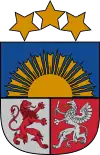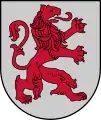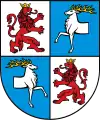Coat of arms of Latvia
Coat of arms of Republic of Latvia was officially adopted by the Constitutional Assembly of Latvia on 15 June 1921, and was in official use from 19 August 1921. It was created using new national symbols and elements of coats of arms of Polish and Swedish Livonia and of the Duchy of Courland and Semigallia. Thus the coat of arms combines symbols of Latvian national statehood, as well as symbols of its historical regions.[1] The Latvian national coat of arms was designed by the Latvian artist Rihards Zariņš.[2]
| Coat of arms of Latvia | |
|---|---|
 Greater version | |
| Versions | |
 Middle version | |
 Lesser version | |
| Armiger | Republic of Latvia |
| Adopted | June 15, 1921 |
| Crest | An arc of three mullets Or |
| Blazon | Per fess and in base per pale: 1st Azure, a demi-sun issuing from base Or; 2nd Argent, a lion rampant contourné Gules; 3rd Gules, a gryphon segreant brandishing in the dexter claw a sword Argent. |
| Supporters | Dexter, a lion rampant Gules, and sinister, a griffin segreant Argent; both langued Or |
| Compartment | Two oak branches fructed Vert tied together by a ribbon Sanguine charged with a bar Argent |
Elements
The three golden stars above the shield represent three historical regions of Latvia: Vidzeme (Swedish Livonia), Latgale (Latgalia or Polish Livonia) and Kurzeme (Courland, usually also representing Zemgale (Semigallia) as the Duchy of Courland and Semigalia) and their unity.[3]
The golden sun in a blue field represents freedom. Sun was also used as a symbol of distinction and national identity used by the Imperial Russian Army's Latvian Riflemen units during World War I.[3] During the war, the sun was fashioned with 17 rays that symbolised the 17 Latvian-inhabited districts.
The bottom part of escutcheon is divided into two fields:
- The red lion from the Coat of arms of Courland represents Courland and Semigallia.[3] The symbol appears as early as 1569 in the coat of arms of the former Duke of Courland and Semigalia.
- The silver griffin from the Coat of arms of Livonia represents Vidzeme and Latgalia.[3] The Gryf coat of arms as the heraldic symbol of the Duchy of Livonia appeared in 1566, when the territories known today as Vidzeme and Latgale had come under the control of the Grand Duchy of Lithuania and Jan Hieronimowicz Chodkiewicz was made the first governor of Duchy of Livonia (1566–78).
The red lion and silver griffin are also used as supporters.[4]
Base of the coat of arms is decorated with the branches of an oak tree, Quercus robur, which is one of Latvia's national symbols.
 Coat of arms of Courland
Coat of arms of Courland Coat of arms of Livonia
Coat of arms of Livonia Emblem of the Latvian National Armed Forces including the sun with 17 rays and three stars
Emblem of the Latvian National Armed Forces including the sun with 17 rays and three stars Greater national coat of arms of Latvia during the first session of the 1st Saeima of the Republic of Latvia in 1922
Greater national coat of arms of Latvia during the first session of the 1st Saeima of the Republic of Latvia in 1922 Three stars on the Freedom Monument in Riga
Three stars on the Freedom Monument in Riga
Usage
The proper use of the Latvian coat of arms is firmly regulated. Three types of symbol are used: the large coat of arms, the small enhanced coat of arms and the small coat of arms.
- The Greater Coat of Arms is used by the President of Latvia, the Parliament, the Prime Minister, the Cabinet of Ministers, government ministries, the Supreme Court and Prosecutor General, as well as Latvian diplomatic and consular missions.[4]
- The Small Enhanced Coat of Arms, (the Middle version) is used by Parliament agencies, the Cabinet of Ministers and other institutions under direct or indirect supervision of government ministries.[4]
- The Small Coat of Arms is used by other government institutions, municipal authorities and educational institutions on official documents.[4]
After the Soviet occupation of Latvia in 1940, the coat of arms was used until 5 August 1940. During the existence of the Latvian Soviet Socialist Republic the emblem of the Latvian Soviet Socialist Republic was used. The Latvian coat of arms was restored once again on 15 February 1990.
Colours
The official colours used in the coat of arms are defined according to the Pantone Colour Matching System thus:
- Red: Pantone 186C
- Green: Pantone 340C
- Blue: Pantone 286C
- Yellow: Pantone 124C
- Golden: Pantone 873C
- Silver: Pantone 877C
- Grey: Pantone 4C
- Black: Pantone Black
Historical coats of arms


 Courland Governorate
Courland Governorate.svg.png.webp) Swedish Livonia
Swedish Livonia Polish Livonia
Polish Livonia Governorate of Livonia
Governorate of Livonia.svg.png.webp) Latvian Socialist Soviet Republic
Latvian Socialist Soviet Republic Emblem of the Latvian Soviet Socialist Republic
Emblem of the Latvian Soviet Socialist Republic
See also
- Flag of Latvia
- National anthem of Latvia
- Emblem of the Latvian Soviet Socialist Republic
- Freedom Monument (Riga)
- Coat of arms of Courland
References
- Latvijas Republikas ģerbonis
- "Rihards Zariņš". Enciklopedija.lv (in Latvian). Retrieved 28 August 2022.
- Žemaitis, Augustinas. "State symbols of Latvia". OnLatvia.com. Retrieved 28 August 2022.
- "The Coat of Arms of Latvia". Latvijas Valsts Prezidents. Archived from the original on 10 August 2014. Retrieved 10 August 2014.
External links
- The Coat of Arms (in French, Latvian, German, Russian, Spanish, Chinese, and Estonian) – basic info at the Latvijas institūts website
.svg.png.webp)